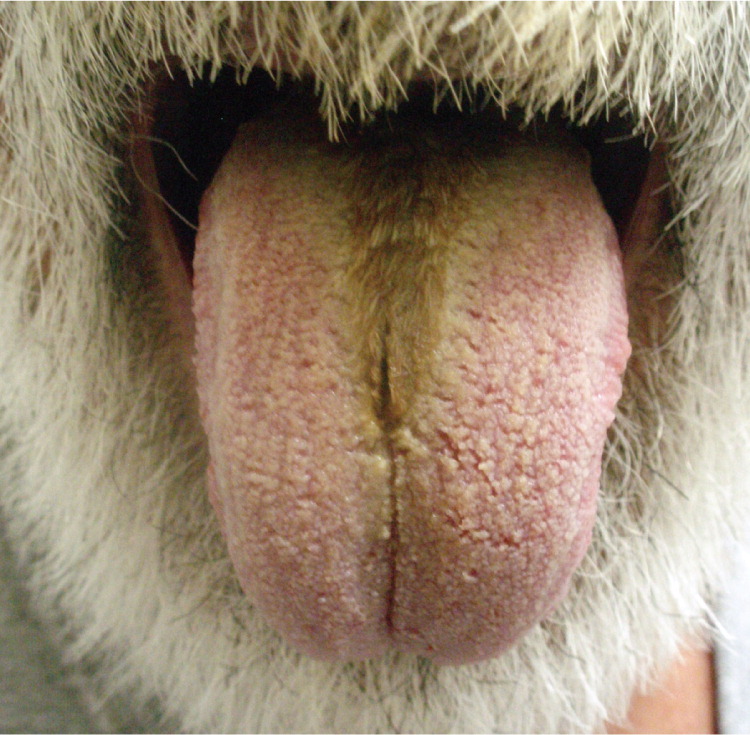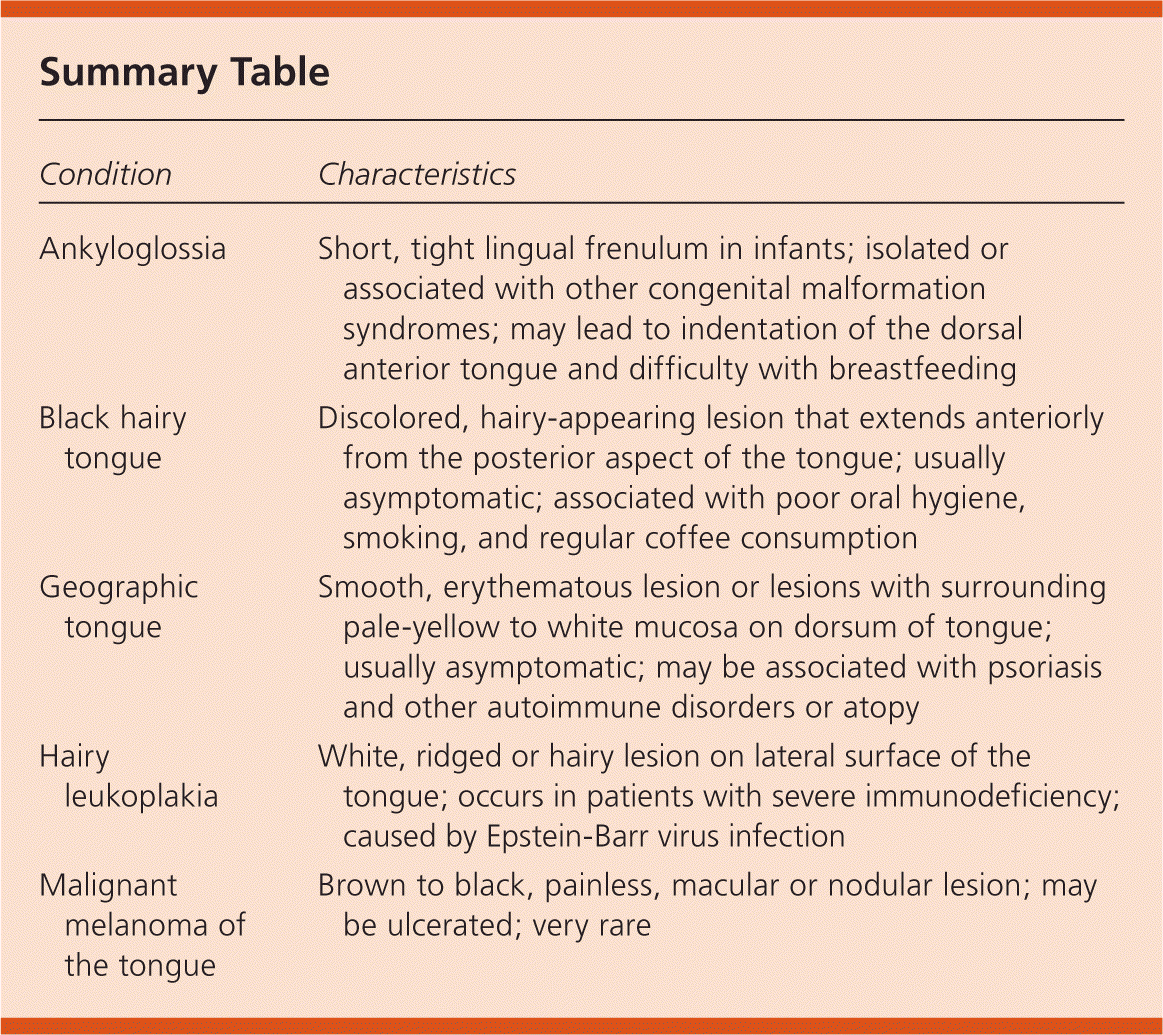
Am Fam Physician. 2011;83(7):839-840
Author disclosure: Nothing to disclose.
A 73-year-old man with type 2 diabetes mellitus presented with a sensation of fullness in his mouth that began two months prior. The patient described the sensation as a “funny feeling in the back of my mouth.” He had no other notable symptoms, such as fever, nausea, weight loss, or night sweats, and his vital signs were normal. The patient was a 30 pack-year smoker, occasionally drank alcohol, and drank coffee daily. He did not use illicit drugs.
Physical examination revealed a brown, hairy-appearing lesion at the midline, covering the posterior two-thirds of his tongue (see accompanying figure). The lesion was approximately 3 × 1 cm, was nontender to palpation, and could not be removed with a tongue blade. The patient had moist oral mucosa; however, dental caries and several missing teeth were noted. He did not have overt halitosis.

Question
Discussion
The answer is B: black hairy tongue. This benign disorder is also referred to as lingua villosa nigra. Black hairy tongue is caused by elongation and hyperplasia of the filiform papillae, along with defective desquamation of the tongue.1–3 Although the name implies that the lesion is black, it may be varying colors, such as brown, yellow, or white. A discolored, hairy-appearing patch extends anteriorly from the posterior aspect of the tongue. The condition is usually asymptomatic, but patients may have nausea, a metallic taste, halitosis, and a sensation of fullness in the back of the mouth.3 Black hairy tongue is not painful.
Predisposing factors for black hairy tongue include poor oral hygiene, smoking, and regular coffee consumption. Development of the condition has been reported after the initiation of olanzapine (Zyprexa)4 or erythromycin.5 Prevention and treatment of black hairy tongue include avoiding risk factors and practicing good oral hygiene, particularly brushing of the posterior tongue surface. Several topical and systemic therapies have been used, including corticosteroids, antifungals, and vitamin preparations. However, given the benign nature of the condition, none is recommended.
Ankyloglossia (tongue-tie) is characterized by a short, tight lingual frenulum in newborn infants. In one study of infants, the incidence rate was 4.8 percent, with a male-to-female ratio of 2.6:1.0.6 The condition can be an isolated physical finding or associated with other congenital malformation syndromes. Ankyloglossia can lead to indentation of the dorsal anterior tongue and difficulty latching on during breastfeeding.6
Geographic tongue (benign migratory glossitis) is characterized by a smooth, erythematous lesion or lesions with surrounding pale-yellow to white mucosa located centrally on the dorsum of the tongue.3,7 In contrast with black hairy tongue, the lesions of geographic tongue are caused by atrophy of the filiform papillae.3 Geographic tongue occurs in patients of all ages and may be associated with psoriasis and other autoimmune disorders or atopy. The condition is usually asymptomatic. Geographic tongue may be chronic or intermittent in nature, or may resolve without recurrence.7
Hairy leukoplakia manifests as a white, ridged or hairy lesion on the lateral surface of the tongue8 that cannot be wiped away with a tongue blade. It is caused by an Epstein-Barr virus infection of the tongue mucosa and occurs in patients with severe immunodeficiency, most commonly those with human immunodeficiency virus infection.9 The incidence of the condition has decreased since the advent of antiretroviral therapy.8 Hairy leukoplakia is benign and may resolve spontaneously.
Malignant melanoma of the tongue is rare. Less than 2 percent of oronasal melanomas occur on the tongue.10 Malignant melanoma of the tongue manifests as a dark, painless, macular or nodular lesion. It may be black or brown and ulcerated. Prognosis is typically poor, with a median five-year survival rate of 25 percent.10

| Condition | Characteristics |
|---|---|
| Ankyloglossia | Short, tight lingual frenulum in infants; isolated or associated with other congenital malformation syndromes; may lead to indentation of the dorsal anterior tongue and difficulty with breastfeeding |
| Black hairy tongue | Discolored, hairy-appearing lesion that extends anteriorly from the posterior aspect of the tongue; usually asymptomatic; associated with poor oral hygiene, smoking, and regular coffee consumption |
| Geographic tongue | Smooth, erythematous lesion or lesions with surrounding pale-yellow to white mucosa on dorsum of tongue; usually asymptomatic; may be associated with psoriasis and other autoimmune disorders or atopy |
| Hairy leukoplakia | White, ridged or hairy lesion on lateral surface of the tongue; occurs in patients with severe immunodeficiency; caused by Epstein-Barr virus infection |
| Malignant melanoma of the tongue | Brown to black, painless, macular or nodular lesion; may be ulcerated; very rare |
